2014 MERCEDES-BENZ GLK-CLASS SUV coolant temperature
[x] Cancel search: coolant temperaturePage 9 of 384

Maximum cooling
.......................... 138
Notes on using automatic climate
control ........................................... 133
Notes on using dual-zone
automatic climate control ..............130
Overview of systems ......................128
Problems with cooling with air
dehumidification ............................ 135
Problem with the rear window
defroster ........................................ 139
Rear control panel .........................132
Refrigerant ..................................... 374
Refrigerant filling capacity .............374
Setting the air distribution .............136
Setting the airflow .........................137
Setting the air vents ......................140
Setting the temperature ................136
Switching air-recirculation mode
on/off ............................................ 139
Switching on/off ........................... 133
Switching residual heat on/off ......139
Switching the rear window
defroster on/off ............................ 138
Switching the ZONE function on/
off .................................................. 137
Coat hooks ......................................... 280
Cockpit Overview .......................................... 32
see Instrument cluster
Collapsible spare wheel
Inflating ......................................... 362
see Emergency spare wheel
COMAND
see separate operating instructions
Combination switch ..........................114
Consumption statistics (on-board
computer) .......................................... 223
Convenience closing feature ..............90
Convenience opening feature ............90
Coolant (engine) Checking the level .........................304
Display message ............................ 247
Filling capacity ............................... 373
Important safety notes ..................372
Temperature gauge ........................ 220
Warning lamp ................................. 269
Cooling
see Climate control Copyright
............................................. 29
Cornering light function Changing bulbs .............................. 121
Display message ............................ 243
Function/notes ............................. 116
Crash-responsive emergency
lighting ............................................... 119
Cruise control Cruise control lever .......................174
Deactivating ................................... 175
Display message ............................ 255
Driving system ............................... 173
Function/notes ............................. 173
Important safety notes ..................173
Setting a speed .............................. 175
Storing and maintaining current
speed ............................................ .174
Cup holder
Center console .............................. 282
Important safety notes ..................282
Rear compartment .........................282
Customer Assistance Center (CAC) ...27
Customer Relations Department .......27 D
Dashboard see Instrument cluster
Dashboard lighting
see Instrument cluster lighting
Data
see Technical data
Daytime running lamps
Display message ............................ 246
Switching on/off (on-board
computer) ...................................... 231
Switching on/off (switch) ..............113
Dealerships
see Qualified specialist workshop
Declarations of conformity ................. 26
DEF Adding ........................................... 162
Display message ............................ 250
Filling capacity ............................... 371
Important safety notes ..................370 Index
7
Page 20 of 384

Telephone
Accepting a call ............................. 227
Display message ............................ 259
Menu (on-board computer) ............227
Number from the phone book ....... .228
Redialing ........................................ 228
Rejecting/ending a call .................227
Temperature
Coolant .......................................... 220
Outside temperature ..................... .221
Setting (climate control) ................136
Theft deterrent systems
ATA (Anti-Theft Alarm system) .........74
Immobilizer ...................................... 73
Time
see separate operating instructions
Tire pressure
Calling up (on-board computer) .....338
Checking manually ........................337
Display message ............................ 256
Important safety notes ..................338
Maximum ....................................... 336
Notes ............................................. 335
Pressure loss warning ....................337
Recommended ............................... 334
Tire pressure loss warning
system
General notes ................................ 337
Important safety notes ..................337
Restarting ...................................... 338
Tire pressure monitoring system
Checking the tire pressure
electronically ................................. 340
Function/notes ............................. 338
General notes ................................ 338
Important safety notes ..................339
Restarting ...................................... 341
Warning lamp ................................. 272
Warning message .......................... 341
Tires
Aspect ratio (definition) .................353
Average weight of the vehicle
occupants (definition) ....................351
Bar (definition) ............................... 351
Changing a wheel .......................... 354
Characteristics .............................. 351
Checking ........................................ 331
Definition of terms .........................351Direction of rotatio
n...................... 354
Display message ............................ 256
Distribution of the vehicle
occupants (definition) ....................354
DOT, Tire Identification Number
(TIN) .............................................. .350
DOT (Department of
Transportation) (definition) ............351
GAWR (Gross Axle Weight Rating)
(definition) ..................................... 352
GTW (Gross Trailer Weight)
(definition) ..................................... 352
GVW (Gross Vehicle Weight)
(definition) ..................................... 352
GVWR (Gross Vehicle Weight
Rating) (definition) .........................352
Important safety notes ..................330
Increased vehicle weight due to
optional equipment (definition) ......351
Kilopascal (kPa) (definition) ...........352
Labeling (overview )........................ 347
Load bearing index (definition) ......353
Load index ..................................... 350
Load index (definition) ...................352
M+S tires ....................................... 332
Maximum loaded vehicle weight
(definition) ..................................... 352
Maximum load on a tire (definition) 353
Maximum permissible tire
pressure (definition) ....................... 352
Maximum tire loa d......................... 345
Maximum tire load (definition) .......352
MOExtended tires ..........................315
Optional equipment weight
(definition) ..................................... 353
PSI (pounds per square inch)
(definition) ..................................... 353
Replacing ....................................... 354
Service life ..................................... 332
Sidewall (definition) .......................353
Speed rating (definition) ................352
Storing ........................................... 355
Structure and characteristics
(definition) ..................................... 351
Summer tires ................................. 332
Temperature .................................. 347
TIN (Tire Identification Number)
(definition) ..................................... 35318
Index
Page 35 of 384
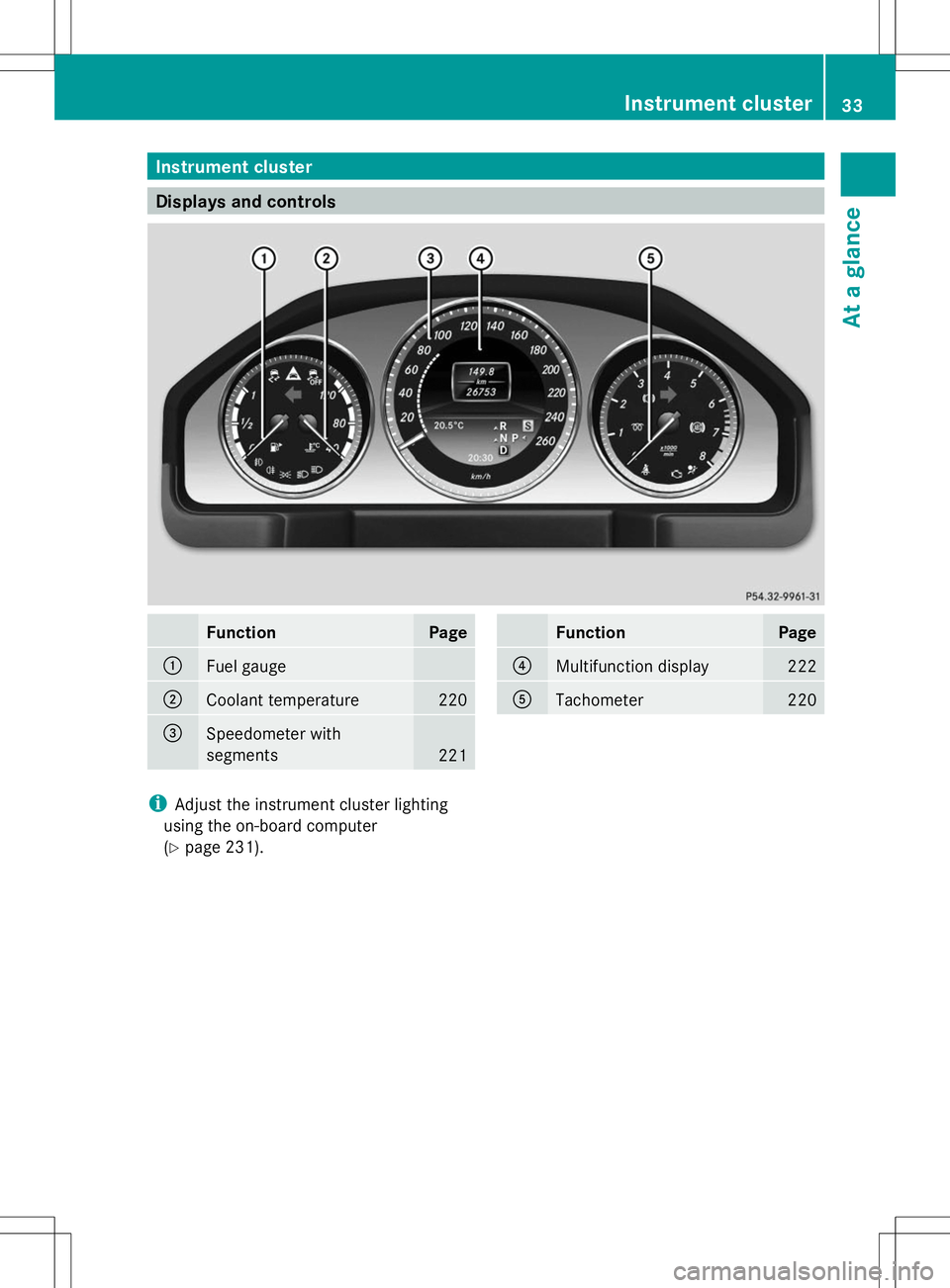
Instrument cluster
Displays and controls
Function Page
:
Fuel gauge
;
Coolant temperature 220
=
Speedometer with
segments
221 Function Page
?
Multifunction display 222
A
Tachometer 220
i
Adjust the instrument cluster lighting
using the on-board computer
(Y page 231). Instrument cluster
33At a glance
Page 154 of 384
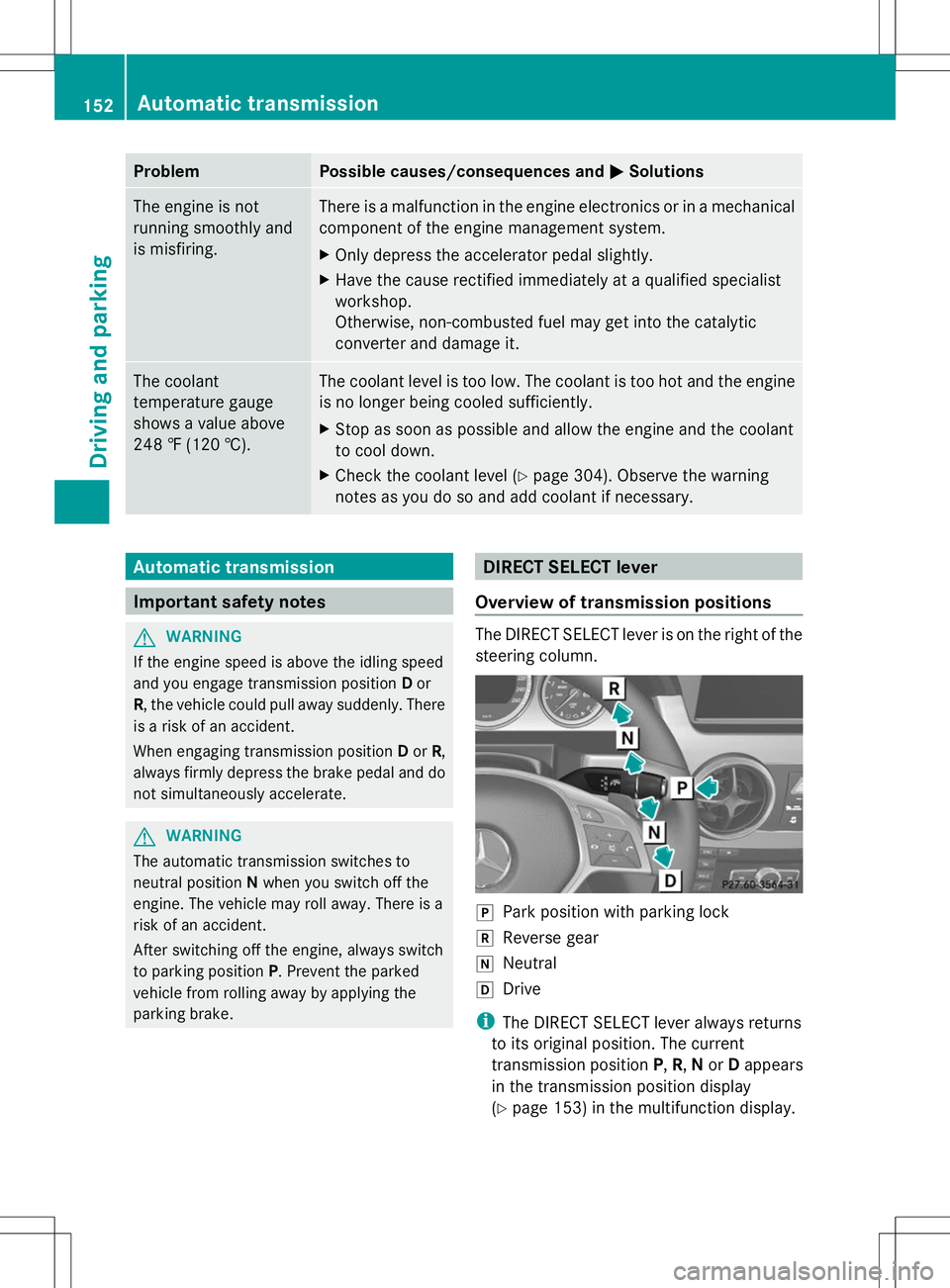
Problem Possible causes/consequences and
M
MSolutions The engine is not
running smoothly and
is misfiring. There is a malfunction in the engine electronics or in a mechanical
component of the engine management system.
X
Only depress the accelerator pedal slightly.
X Have the cause rectified immediately at a qualified specialist
workshop.
Otherwise, non-combusted fuel may get into the catalytic
converter and damage it. The coolant
temperature gauge
shows a value above
248 ‡ (120 †). The coolant level is too low. The coolant is too hot and the engine
is no longer being cooled sufficiently.
X
Stop as soon as possible and allow the engine and the coolant
to cool down.
X Check the coolant level (Y page 304). Observe the warning
notes as you do so and add coolant if necessary. Automatic transmission
Important safety notes
G
WARNING
If the engine speed is above the idling speed
and you engage transmission position Dor
R, the vehicle could pull away suddenly. There
is a risk of an accident.
When engaging transmission position Dor R,
always firmly depress the brake pedal and do
not simultaneously accelerate. G
WARNING
The automatic transmission switches to
neutral position Nwhen you switch off the
engine. The vehicle may roll away. There is a
risk of an accident.
After switching off the engine, always switch
to parking position P. Prevent the parked
vehicle from rolling away by applying the
parking brake. DIRECT SELECT lever
Overview of transmission positions The DIRECT SELECT lever is on the right of the
steering column.
j
Park position with parking lock
k Reverse gear
i Neutral
h Drive
i The DIRECT SELECT lever always returns
to its original position. The current
transmission position P,R, Nor Dappears
in the transmission position display
(Y page 153) in the multifunction display. 152
Automatic transmissionDriving and parking
Page 217 of 384
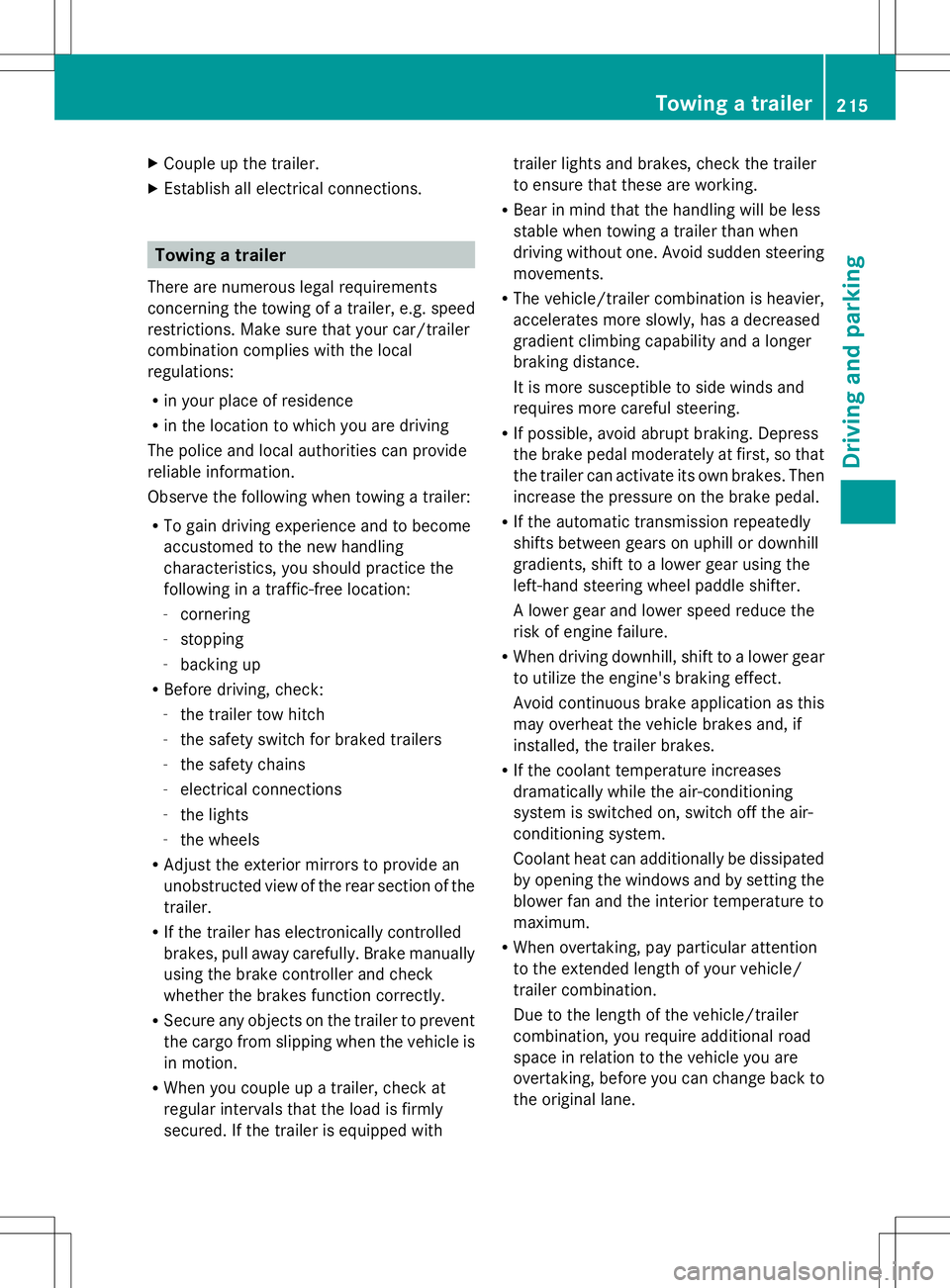
X
Couple up the trailer.
X Establish all electrical connections. Towing a trailer
There are numerous legal requirements
concerning the towing of a trailer, e.g. speed
restrictions. Make sure that your car/trailer
combination complies with the local
regulations:
R in your place of residence
R in the location to which you are driving
The police and local authorities can provide
reliable information.
Observe the following when towing a trailer:
R To gain driving experience and to become
accustomed to the new handling
characteristics, you should practice the
following in a traffic-free location:
- cornering
- stopping
- backing up
R Before driving, check:
-the trailer tow hitch
- the safety switch for braked trailers
- the safety chains
- electrical connections
- the lights
- the wheels
R Adjust the exterior mirrors to provide an
unobstructed view of the rear section of the
trailer.
R If the trailer has electronically controlled
brakes, pull away carefully. Brake manually
using the brake controller and check
whether the brakes function correctly.
R Secure any objects on the trailer to prevent
the cargo from slipping when the vehicle is
in motion.
R When you couple up a trailer, check at
regular intervals that the load is firmly
secured. If the trailer is equipped with trailer lights and brakes, check the trailer
to ensure that these are working.
R Bear in mind that the handling will be less
stable when towing a trailer than when
driving without one. Avoid sudden steering
movements.
R The vehicle/trailer combination is heavier,
accelerates more slowly, has a decreased
gradient climbing capability and a longer
braking distance.
It is more susceptible to side winds and
requires more careful steering.
R If possible, avoid abrupt braking. Depress
the brake pedal moderately at first, so that
the trailer can activate its own brakes. Then
increase the pressure on the brake pedal.
R If the automatic transmission repeatedly
shifts between gears on uphill or downhill
gradients, shift to a lower gear using the
left-hand steering wheel paddle shifter.
A lower gear and lower speed reduce the
risk of engine failure.
R When driving downhill, shift to a lower gear
to utilize the engine's braking effect.
Avoid continuous brake application as this
may overheat the vehicle brakes and, if
installed, the trailer brakes.
R If the coolant temperature increases
dramatically while the air-conditioning
system is switched on, switch off the air-
conditioning system.
Coolant heat can additionally be dissipated
by opening the windows and by setting the
blower fan and the interior temperature to
maximum.
R When overtaking, pay particular attention
to the extended length of your vehicle/
trailer combination.
Due to the length of the vehicle/trailer
combination, you require additional road
space in relation to the vehicle you are
overtaking, before you can change back to
the original lane. Towing a trailer
215Driving and parking Z
Page 222 of 384
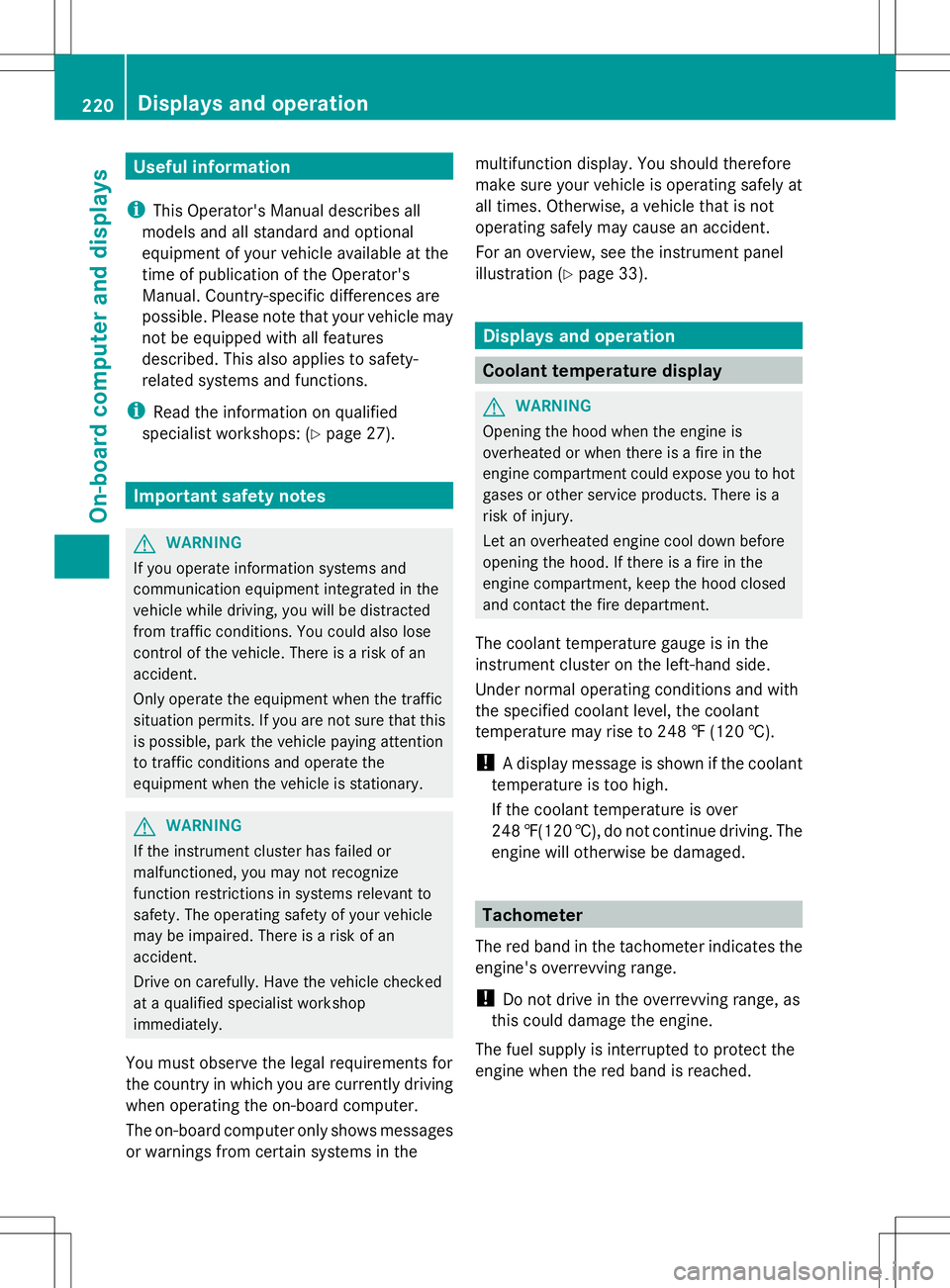
Useful information
i This Operator's Manual describes all
models and all standard and optional
equipment of your vehicle available at the
time of publication of the Operator's
Manual. Country-specific differences are
possible. Please note that your vehicle may
not be equipped with all features
described. This also applies to safety-
related systems and functions.
i Read the information on qualified
specialist workshops: (Y page 27).Important safety notes
G
WARNING
If you operate information systems and
communication equipment integrated in the
vehicle while driving, you will be distracted
from traffic conditions. You could also lose
control of the vehicle. There is a risk of an
accident.
Only operate the equipment when the traffic
situation permits. If you are not sure that this
is possible, park the vehicle paying attention
to traffic conditions and operate the
equipment when the vehicle is stationary. G
WARNING
If the instrument cluster has failed or
malfunctioned, you may not recognize
function restrictions in systems relevant to
safety. The operating safety of your vehicle
may be impaired. There is a risk of an
accident.
Drive on carefully. Have the vehicle checked
at a qualified specialist workshop
immediately.
You must observe the legal requirements for
the country in which you are currently driving
when operating the on-board computer.
The on-board computer only shows messages
or warnings from certain systems in the multifunction display. You should therefore
make sure your vehicle is operating safely at
all times. Otherwise, a vehicle that is not
operating safely may cause an accident.
For an overview, see the instrument panel
illustration (Y
page 33). Displays and operation
Coolant temperature display
G
WARNING
Opening the hood when the engine is
overheated or when there is a fire in the
engine compartment could expose you to hot
gases or other service products. There is a
risk of injury.
Let an overheated engine cool down before
opening the hood. If there is a fire in the
engine compartment, keep the hood closed
and contact the fire department.
The coolant temperature gauge is in the
instrument cluster on the left-hand side.
Under normal operating conditions and with
the specified coolant level, the coolant
temperature may rise to 248 ‡ (120 †).
! A display message is shown if the coolant
temperature is too high.
If the coolant temperature is over
248 ‡(120 †), do not continue driving. The
engine will otherwise be damaged. Tachometer
The red band in the tachometer indicates the
engine's overrevving range.
! Do not drive in the overrevving range, as
this could damage the engine.
The fuel supply is interrupted to protect the
engine when the red band is reached. 220
Displays and operationOn-board computer and displays
Page 249 of 384
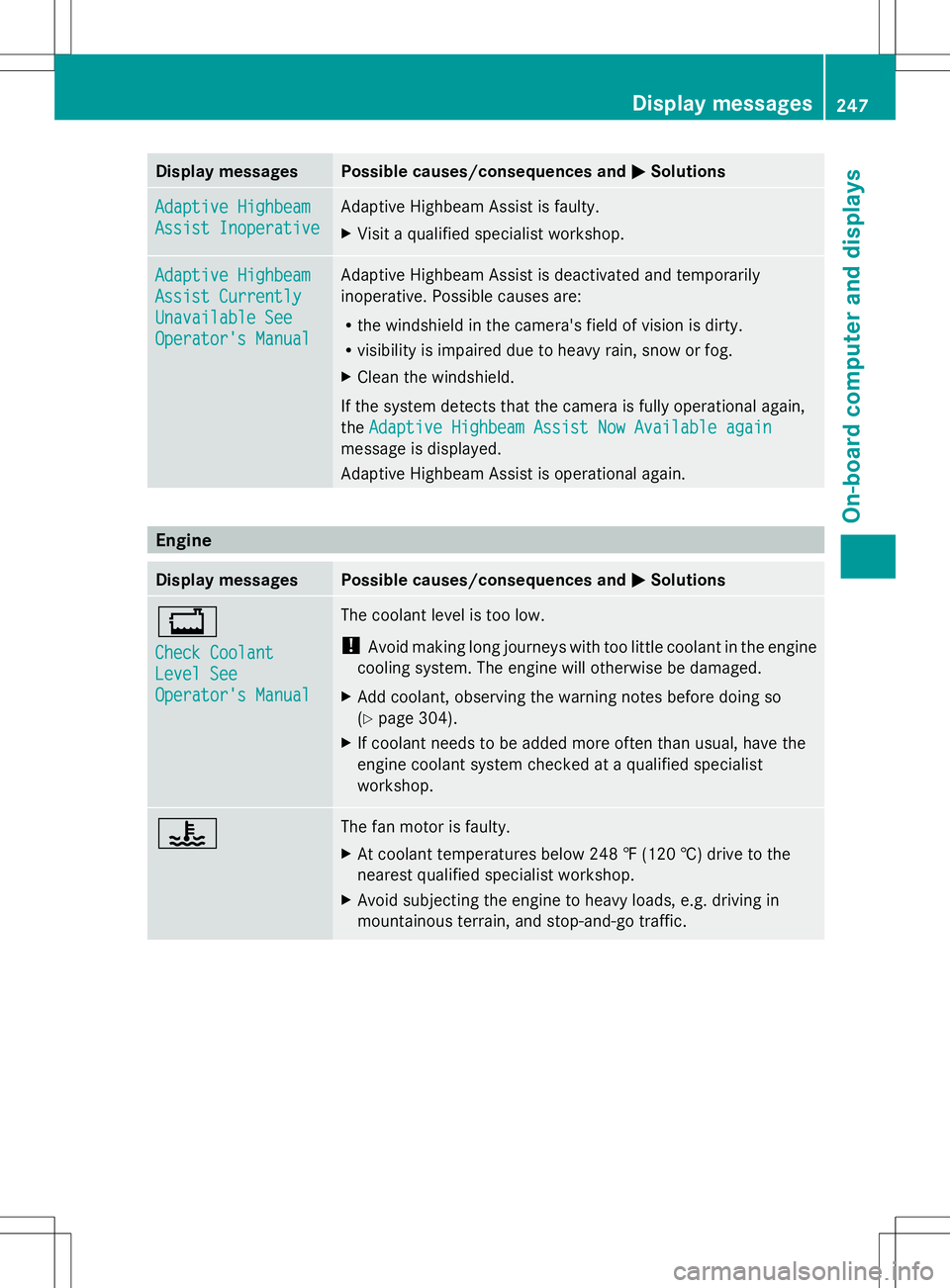
Display messages Possible causes/consequences and
M
MSolutions Adaptive Highbeam
Adaptive Highbeam
Assist Inoperative Assist Inoperative Adaptive Highbeam Assist is faulty.
X
Visit a qualified specialist workshop. Adaptive Highbeam Adaptive Highbeam
Assist Currently Assist Currently
Unavailable See Unavailable See
Operator's Manual Operator's Manual Adaptive Highbeam Assist is deactivated and temporarily
inoperative. Possible causes are:
R
the windshield in the camera's field of vision is dirty.
R visibility is impaired due to heavy rain, snow or fog.
X Clean the windshield.
If the system detects that the camera is fully operational again,
the Adaptive Highbeam Assist Now Available again Adaptive Highbeam Assist Now Available again
message is displayed.
Adaptive Highbeam Assist is operational again. Engine
Display messages Possible causes/consequences and
M MSolutions +
Check Coolant Check Coolant
Level See Level See
Operator's Manual Operator's Manual The coolant level is too low.
!
Avoid making long journeys with too little coolant in the engine
cooling system. The engine will otherwise be damaged.
X Add coolant, observing the warning notes before doing so
(Y page 304).
X If coolant needs to be added more often than usual, have the
engine coolant system checked at a qualified specialist
workshop. ? The fan motor is faulty.
X
At coolant temperatures below 248 ‡ (120 †) drive to the
nearest qualified specialist workshop.
X Avoid subjecting the engine to heavy loads, e.g. driving in
mountainous terrain, and stop-and-go traffic. Display
messages
247On-board computer and displays Z
Page 250 of 384
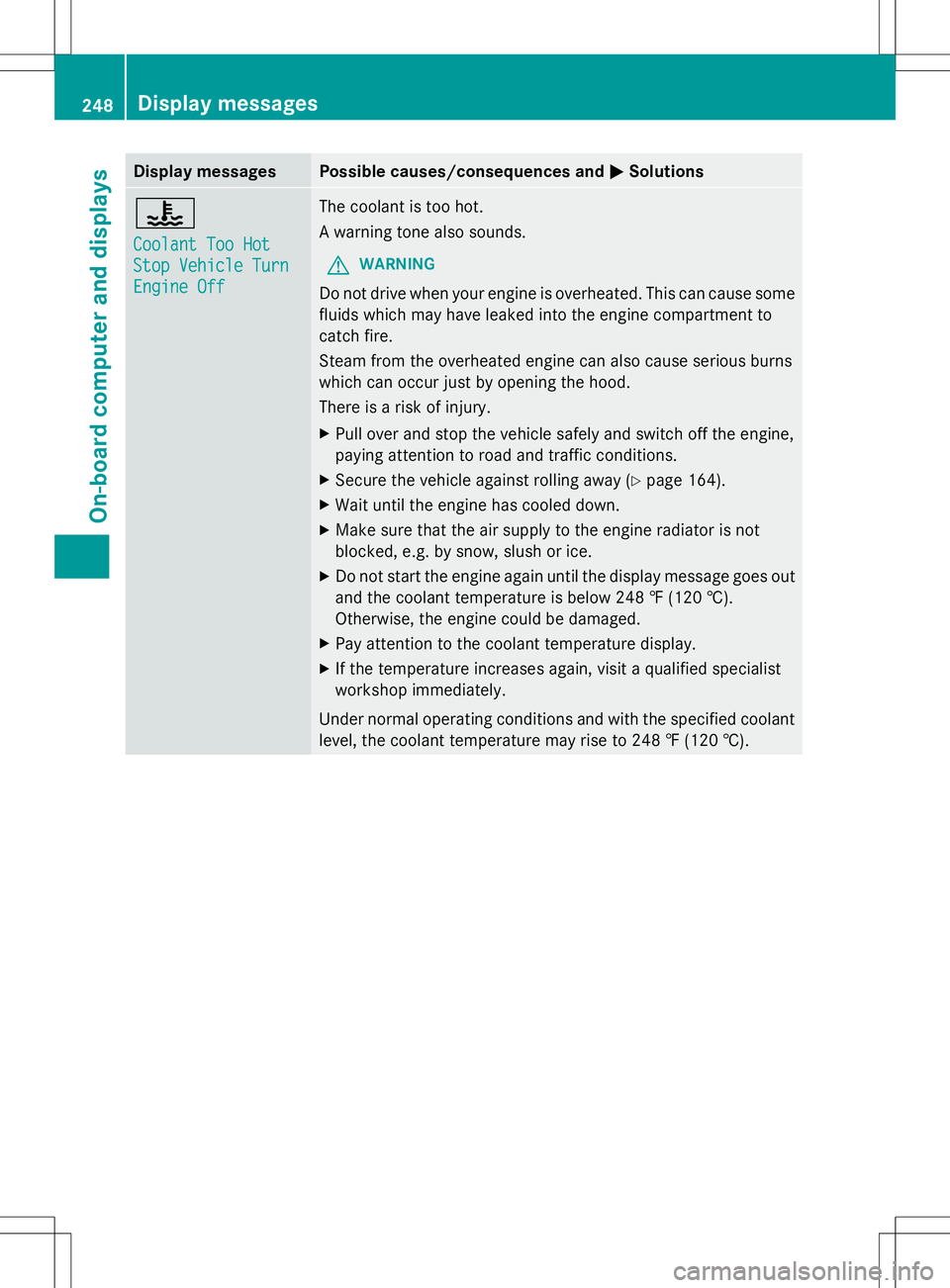
Display messages Possible causes/consequences and
M
MSolutions ?
Coolant Too Hot Coolant Too Hot
Stop Vehicle Turn Stop Vehicle Turn
Engine Off Engine Off The coolant is too hot.
A warning tone also sounds.
G WARNING
Do not drive when your engine is overheated. This can cause some
fluids which may have leaked into the engine compartment to
catch fire.
Steam from the overheated engine can also cause serious burns
which can occur just by opening the hood.
There is a risk of injury.
X Pull over and stop the vehicle safely and switch off the engine,
paying attention to road and traffic conditions.
X Secure the vehicle against rolling away ( Ypage 164).
X Wait until the engine has cooled down.
X Make sure that the air supply to the engine radiator is not
blocked, e.g. by snow, slush or ice.
X Do not start the engine again until the display message goes out
and the coolant temperature is below 248 ‡ (120 †).
Otherwise, the engine could be damaged.
X Pay attention to the coolant temperature display.
X If the temperature increases again, visit a qualified specialist
workshop immediately.
Under normal operating conditions and with the specified coolant
level, the coolant temperature may rise to 248 ‡ (120 †). 248
Display
messagesOn-board computer and displays